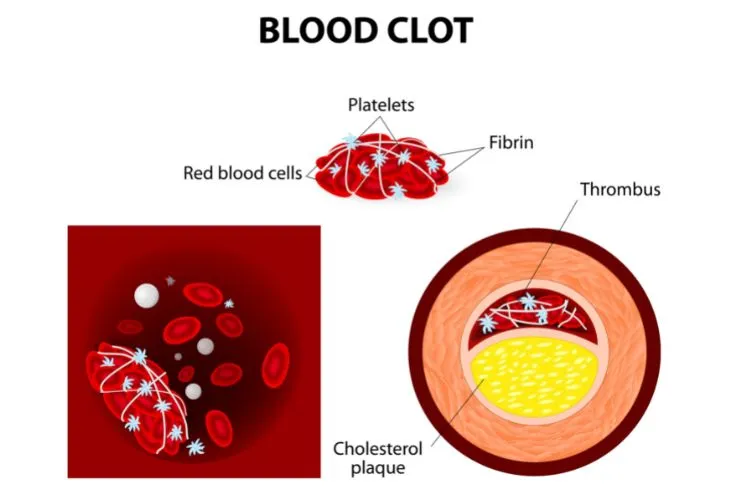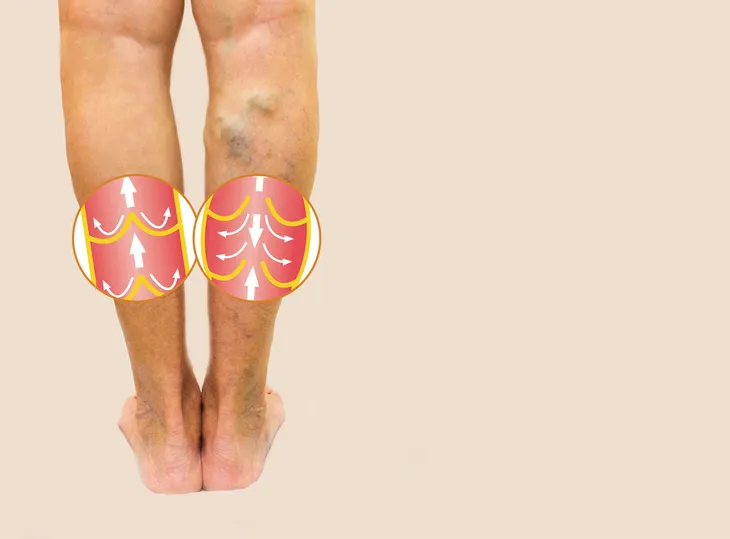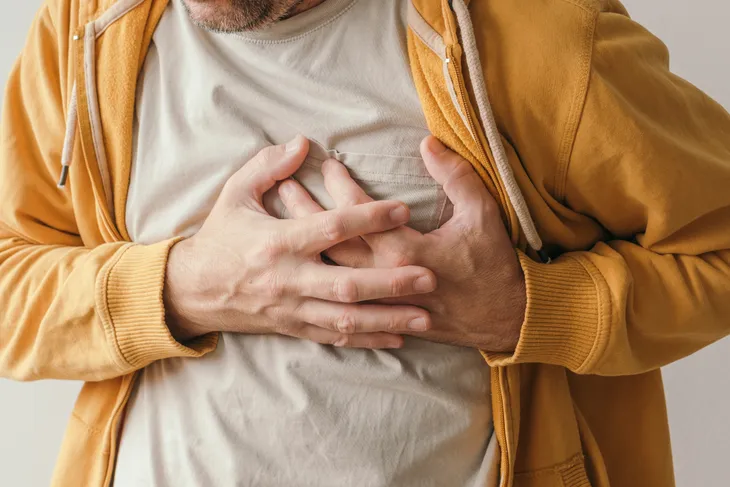- Blood clots are gel-like lumps of blood that form in the veins or arteries when blood goes from liquid to partially solid.
- While they are helpful for stopping bleeding, if they form unnecessarily they can be life threatening.
- There are many myths surrounding blood clots, from how common they are to who’s at risk.
- To prevent blood clots, be active, eat healthy, don’t smoke, and avoid sitting for long periods of time.
Blood clots are a double edge sword. In some cases they are healthy or even lifesaving when they stop bleeding. However, if they form when not needed, they can be extremely dangerous, causing a heart attack, stroke, or other serious medical problems.
You might not have experienced a blood clot personally, but have likely heard about them as a possible side effect of medication or lifestyle choices. To get better informed on the topic, we’ve compiled a list of common myths surrounding blood clots and what the truth is behind them…
What are Blood Clots?
First let’s distinguish what exactly a blood clot is. The Cleveland Clinic explains that blood clots are essentially gel-like clumps of blood that form in the veins or arteries when blood goes from liquid to partially solid. Clotting is normal and can help stop bleeding, however if they form in areas of the body where they are not needed and don’t dissolve on their own, they can be dangerous.
A clot typically starts in response to an injury. “Two substances — platelets (a type of blood cell) and fibrin (a firm string-like substance) – combine to form what is called a platelet plug to stop up the cut or hole,” writes the Cleveland Clinic. If a clot forms in a vein or artery, it’s called a thrombus.
Symptoms and treatment will depend on where in the body the blood clot forms.
Blood Clots Only Happen to Older Adults
Many young adults assume because of their age they don’t have to worry about getting a blood clot. Unfortunately, blood clots happen to anyone. People of all ages can get them — even those who live an active lifestyle.
Age is certainly a risk factor for blood clots, but don’t assume they only happen to older adults. People who are in their physical prime still get them. It’s just that they are more common in older patients with poor health, explains Northwest Career College.
DVT Isn’t Serious
You might be thinking, DVT? What is that? I’ve never heard of it so it can’t be that serious. While it’s not often talked about, according to Hematology.com, complications from DVT actually takes more lives each year than breast cancer, HIV, and car accidents combined.
DVT stands for deep vein thrombosis. It’s a blood clot that forms inside a vein of the leg, or sometimes the arms, pelvis, and other large veins. “In some cases, a clot in a vein may detach from its point of origin and travel through the heart to the lungs where it becomes wedged, preventing adequate blood flow,” writes the source. If this happens it’s called a pulmonary embolism (PE) which is life threatening.
DVT is a Rare Condition
Even though it’s not often talked about, DVT is actually fairly common. It’s estimated that 900,000 people are affected by DVT/PE each year in the U.S., says hematology.org. Within those numbers, approximately 100,000 Americans succumb to this condition.
While some people are more at risk of DVT, it can happen to anyone and result in serious illness or be fatal. People who are more at risk are those who have recently had major surgery, cancer, heart or lung disease, or have a family history of DVT.
Women are at a Higher Risk
This myth is partially true. Many people believe that because of the risks associated with DVT while pregnant and using medication to prevent pregnancy, women are the only ones who need to be concerned about blood clots. While it’s true, their risk is higher while pregnant and using certain medications, men are by no means immune.
In fact, Hematology.com notes that overall men are at a higher risk. The occurrence of DVT and PE is statistically higher in men than women.
Medication to Prevent Pregnancy Cause Blood Clots
Some women might be afraid to use medication to prevent pregnancy because they’ve heard they cause blood clots. This isn’t true. While there is an increased risk, most women don’t have any complications. “While studies have shown increased risk of blood clots while taking [it] due to increased estrogen, the vast majority of women who take these medications will have no complications,” writes Hematology.org.
You can lower the risk of blood clots by maintaining a healthy weight, eating healthy, and not smoking. Unfortunately, women over 40 will have an increased risk, but this is uncontrollable. A doctor can help discuss the risks and benefits of using it.
Blood Clots Only Occur at Home or During Travel
This is probably one of the most common myths associated with blood clots. People believe they only happen while traveling on planes for long periods of time or people who sit on the couch at home all day.
While it’s true, people who travel regularly and are cramped in small spaces are at an increased risk, the most common place they happen are in hospitals, says Northwest Career College. They occur here more than anywhere else.
I’m in Great Shape, I Don’t Have to Worry
While the risk of blood clots is certainly higher in people who live an inactive lifestyle, they can happen to anyone — even athletes. In fact, Hematolgoy.org points out that athletes are at an increased risk for blood clots.
This is because they are more susceptible to injury, being dehydrated, and more likely to travel long distances for games and events. However, being in good shape is also a great way to deter blood clots from happening in the first place.
Blood Thinners are Only for Coagulum
There is a myth circulating that blood thinners can only be administered to people experiencing a coagulum (another term for blood clot). This isn’t true. According to Phlebotomy Training Specialists, blood clots can remain or break up even more in patients who go off blood thinners too quickly. New clots can also form.
“A patient I just saw this week had a history of blood clots when she was on [medication to prevent pregnancy],” says Dr. Andra James, a professor at Duke University Medical School. “She had factor V Leiden (a genetic blood clotting disorder), but at eight weeks pregnant, she was not on an anticoagulant (blood thinner). This patient should have had a plan in place. She didn’t,” says James, “and she had a DVT.”
I Would Know If I Had One
One of the scariest aspects of blood clots and DVT in particular is that it can occur without any symptoms. People assume they would know if they had a blood clot, but it can actually be quite silent.
The symptoms associated with blood clots depends on where in the body they occur. Don’t assume that a lack of pain means there isn’t a blood clot. The most common symptom is swelling. While pain will likely occur if the clot is in the leg, thigh, or abdomen, some people have no symptoms at all, notes the Cleveland Clinic.
Risk Factors for Blood Clots
Technically, any person can get a blood clot, but some people are at a higher risk of developing thrombus clots. Overall, clots are more common as we age, especially for people over the age of 65, says the Cleveland Clinic.
Other factors that can increase a persons risk are certain medications or hormone replacement therapy, pregnancy, cancer (or been treated for cancer), family history of blood clots, overweight, obesity, sedentary lifestyle, and smoking.
How to Prevent Blood Clots
As we already mentioned, anyone can get blood clots. Even perfectly healthy individuals. Also, some risk factors are unavoidable, such as age, family history, or personal medical history (i.e. cancer, major surgery). Thankfully, despite all this, there are still things we can do to try and prevent them.
The first is to maintain a healthy body weight and stay active. You don’t have to be an athlete or partake in vigorous exercise. Just be mindful of moving your body regularly. Avoid sitting for long periods of time. The Centers for Disease Control and Prevention (CDC) recommends people stand, stretch and move around every 2 to 3-hours to prevent blood clots.
Other easy things we can all do is drink lots of water, be mindful of sodium levels, and don’t smoke.















